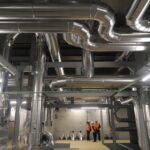There’s no doubt about it, 2023 was a gangbuster year in the data center industry. It’s not often that my lay-person friends and family actually know what I’m talking about when I gush about cool data center news, but this year, they had some context as AI and technology developments made their way to the mainstream outlets.
So far, DCN has published over 1,400 articles in 2023 – and as I look back at our data center news and trends, a few big themes stick out. I’ve curated the top three, along with thoughts for the upcoming year. These are the most important trends that you need to consider as you’re planning your first steps in 2024.
AI Ethics and Governance
No story in 2023 had a bigger impact on the data center industry than generative AI. Google, Amazon, Meta, and Microsoft data centers have notably been upgraded to accommodate the ever-increasing push for more operational capacity, thanks to the intense need for more computation as the system slices and dices through all those algorithms. Currently 20% of global data center capacity is used for AI, and this technology is absolutely insatiable. All of that AI buzz hasn’t escaped the notice of the C-suites, with more business demand for AI in 2024, data center professionals will need to be responsive to AI tools coming left and right from the profit centers. A single AI model can chomp through thousands of kilowatt-hours and with most data centers already running near peak, disruption is here.
That said, the industry has always had an impulse problem at its core – we accomplish new technology innovations before it ever occurs to us to ask if we should. It took until October of 2023 before even the White House made an AI Ethics statement. And we all know that the machine learning and language skills are being trained from some pretty dubious data (most notably a week ago when the LAION5-B data set was found to contain extremely disturbing images).
Ultimately, business not consumers are pushing the AI trend in efforts to get ahead and/or cut costs (aka staff). While a lash back is coming, it won’t be in 2024. And the biggest concern for data center operators in 2024 will be not only capacity but guarding the gate – possibly the literal gate of the data center — against bad actors using AI for nefarious means and data harvesting.
Data Center Sustainability is No Longer a ‘Nice to Have’ – It’s Table Stakes
In 2023, according to Cushman Wakefield, data centers ate through 7.4 GW of power. This is a 50% increase (!!!) over 2022’s 4.9 GW attributed to data centers. This is difficult for most people to grasp, but that’s the equivalent of powering 6.5 million average American homes. The appetite for power will grow along with the expanding data center landscape and with the cost of power going up, finding cheaper ways to keep the lights on is job one for the data center leadership or be blamed for a future power shortage.
But sustainability isn’t just a buzzword for environmental-responsibility and climate change reactions, it’s also about business sustainability from the foundation up. Between smart building decisions, site locations all the way to supply chain and talent recruitment, sustainable business practices need to feather through every aspect of the data center. It’s not enough to have a white roof and LED lightbulbs (you have done that already, right?) and pay off carbon credits to make the number crunchers and marketing team happy – with data centers accountable for 4% of all energy consumption and a growing concern over water sourcing in municipalities at a time when many in the industry are turning toward liquid cooling, things are about to get real – and fast. The leaders in the industry who commit fully to sustainable business practices may be challenged by the C-suite initially but those types of paradigm shifts now will find them outpacing competitors in the years to come. But they need to be making those investments now to win the long game.
Data center operators already are feeling the burn from increased AI use cases deployed by the business, and are stuck in a cycle of endless upgrading and mitigating operational complexities. With computational power doubling every two to four months, what they’re doing today won’t be sustainable by mid-year. Data centers are very much following the Red Queen in Alice in Wonderland who said “Here, you see, it takes all the running you can do to keep in the same place. If you want to get somewhere else, you must run at least twice as fast as that.” The faster you burn, the faster you HAVE to burn. That’s why the key differentiator will be a clear focus on sustainable business practices – both in terms of energy consumption and water usage but also making sure that we don’t burn out.
Regulation/NIMBYism Push Back
Data center operators have long operated under the pleasant subterfuge of residential anonymity – most people had no idea what data centers are and have been told that they’re “some kind of computer thing” from local governments hoping to become the third wave next Silicon Valley. We’ve already seen this in Virginia, and FoxConn has set a pretty bad taste in the public’s mouth about the tech hustle evaporating once it passes at the county level. Our own Bill Kleymann came face to face with protesters this year on a site visit.
While the public might love their streaming content and superfast internet speeds, when faced with living living down the street from walls of server farms, they’d rather not. Municipality appetites for the tax base are waning due to residential noise concerns, environmental impact to water, land conservation, heritage and energy consumption, not to mention lawmakers burning their political equity. Data center giants like Google and Meta have needed to pull back on new builds due to local pushback in the last eighteen months. Expect a tsunami wave of NIMBYism in 2024 and beyond, with new site selection to get a whole lot hairier in the years to come.




